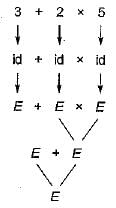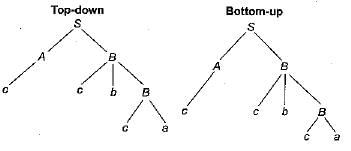Test: Parsing Techniques- 2 - Computer Science Engineering (CSE) MCQ
15 Questions MCQ Test - Test: Parsing Techniques- 2
Which of the following actions an operator- precedence parser may take to recover from an error?
Which of the following is the important factor that justifies the use of a stack in shift-reduce parsing?
| 1 Crore+ students have signed up on EduRev. Have you? Download the App |
A shift reduce parser carries out the actions specified with in braces immediately after reducing the corresponding rule of grammar.

What is the translation of bbbbacc using the syntax directed translation scheme described by the above rules?

Which of the following statements are TRUE?
I. Top-down parsers are equipped to handle left recursive grammar.
II. LALR parser is more powerful than an SLR parser.
III. Recursive descent parsing is an example of top-down parsing.
For a context-free grammar, FOLLOW(A) is the set of terminals that can appear immediately to the right of non-terminal A in some “sentential” form. We defined to sets LFOLLOW(A) and RFOLLOW(A) by replacing the word “left most sentential” and “right most sentential” respectively in the definition of FOLLOW(A).
Which of the following statements is/are true
Consider the following expression grammar, The semantic rules for expression calculation-are stated next to each grammar production.

The above grammar and the semantic rules are fed to a yacc tool (which is an LALR(1) parser generator) for parsing and evaluating arithmetic expressions. Which one of the following is true about the action of yacc for the given grammar?
Which of the following describes a handle (as applicable to LR-parsing) appropriately?
An LALR(1) parser for a grammar G can have shift-reduce (S-R) conflicts if and only if
Consider the following grammar production:

Which of the following is not LR(1) item set?
Consider the production:
S→ aS | b
The parsing automation is below:

Which of the following stack contents causes the parser to reduce by some production?
Consider the following grammar production:

The expression 3 + 2 x 5 is parsed by the shift- reduce parser then which of the following is not a handle for it?
Consider a grammar:

The input string ccbca is parsed by which of the following parsing method?





 since Y→a production not present in grammar.
since Y→a production not present in grammar.

















